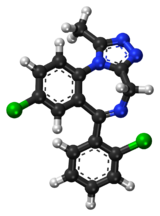 | |
 | |
| Clinical data | |
|---|---|
| Trade names | Halcion, others |
| AHFS/Drugs.com | Monograph |
| MedlinePlus | a684004 |
| License data | |
| Pregnancy category |
|
| Routes of administration | By mouth |
| ATC code | |
| Legal status | |
| Legal status |
|
| Pharmacokinetic data | |
| Bioavailability | 44% (oral route), 53% (sublingual) |
| Metabolism | Liver |
| Onset of action | 15–30 minutes[4] |
| Elimination half-life | 1.5–5.5 hours |
| Excretion | Kidney |
| Identifiers | |
| |
| CAS Number | |
| PubChem CID | |
| IUPHAR/BPS | |
| DrugBank | |
| ChemSpider | |
| UNII | |
| KEGG | |
| ChEBI | |
| ChEMBL | |
| CompTox Dashboard (EPA) | |
| ECHA InfoCard | 100.044.811 |
| Chemical and physical data | |
| Formula | C17H12Cl2N4 |
| Molar mass | 343.21 g·mol−1 |
| 3D model (JSmol) | |
| |
| |
| (verify) | |
Triazolam, sold under the brand name Halcion among others, is a central nervous system (CNS) depressant tranquilizer of the triazolobenzodiazepine (TBZD) class, which are benzodiazepine (BZD) derivatives.[5] It possesses pharmacological properties similar to those of other benzodiazepines, but it is generally only used as a sedative to treat severe insomnia.[6][unreliable medical source?] In addition to the hypnotic properties, triazolam's amnesic, anxiolytic, sedative, anticonvulsant, and muscle relaxant properties are pronounced as well.[7]
Triazolam was initially patented in 1970 and went on sale in the United States in 1982.[8] In 2017, it was the 289th most commonly prescribed medication in the United States, with more than one million prescriptions.[9]
- ^ "Triazolam (Halcion) Use During Pregnancy". Drugs.com. 18 September 2020. Retrieved 24 October 2020.
- ^ "FDA-sourced list of all drugs with black box warnings (Use Download Full Results and View Query links.)". nctr-crs.fda.gov. FDA. Retrieved 22 October 2023.
- ^ Anvisa (31 March 2023). "RDC Nº 784 - Listas de Substâncias Entorpecentes, Psicotrópicas, Precursoras e Outras sob Controle Especial" [Collegiate Board Resolution No. 784 - Lists of Narcotic, Psychotropic, Precursor, and Other Substances under Special Control] (in Brazilian Portuguese). Diário Oficial da União (published 4 April 2023). Archived from the original on 3 August 2023. Retrieved 16 August 2023.
- ^ "What Is Triazolam Used For?". www.icliniq.com. 1 November 2022. Retrieved 30 January 2023.
- ^ "Benzodiazepine Names". non-benzodiazepines. Archived from the original on 8 December 2008. Retrieved 29 December 2008.
- ^ Wishart, David (2006). "Triazolam". DrugBank. Retrieved 23 March 2006.
- ^ Mandrioli R, Mercolini L, Raggi MA (October 2008). "Benzodiazepine metabolism: an analytical perspective". Current Drug Metabolism. 9 (8): 827–844. doi:10.2174/138920008786049258. PMID 18855614.
- ^ Shorter E (2005). "B". A Historical Dictionary of Psychiatry. Oxford University Press. ISBN 9780190292010.
- ^ "Triazolam - Drug Usage Statistics". ClinCalc. Retrieved 7 October 2022.